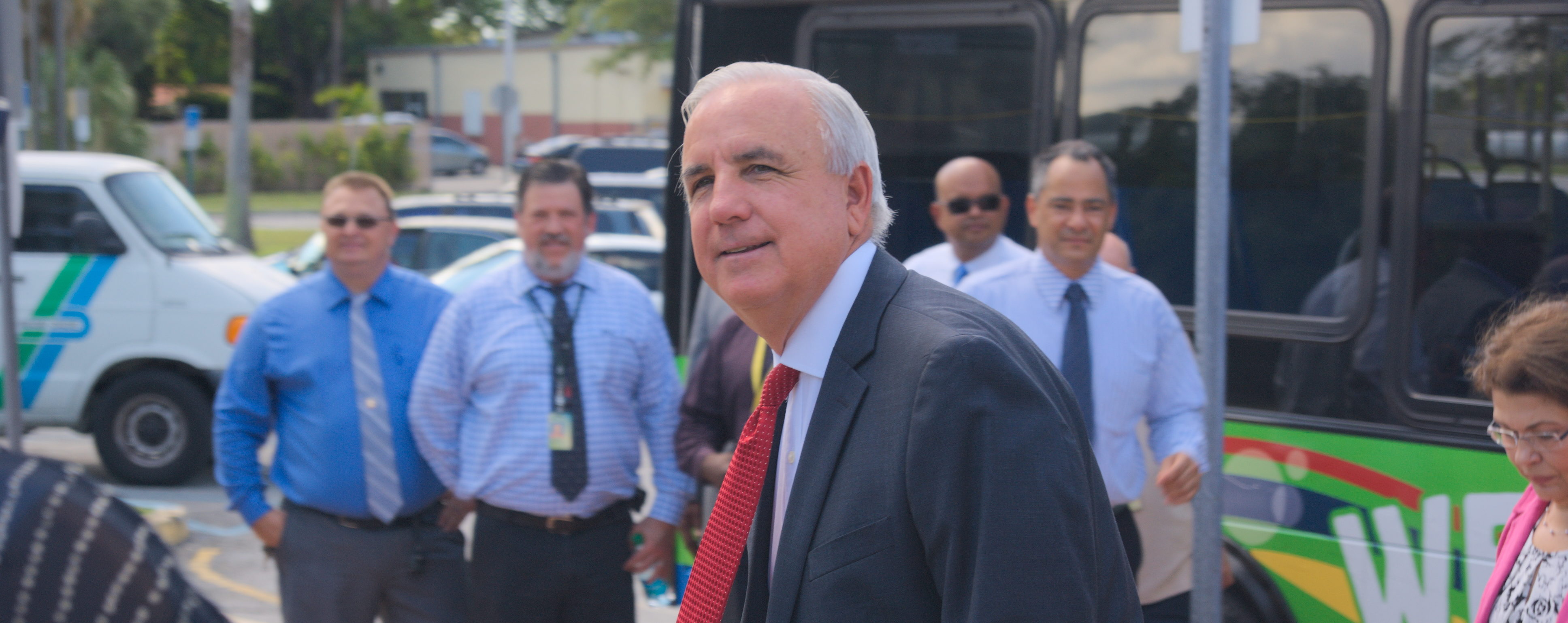
Photo credit: SONY DSC
The neglect of the Miami-Dade transit system (MDT) under Mayor Carlos Gimenez has become shockingly literal. According to the local chapter of the Transport Workers Union (TWU), a quarter of Miami-Dade buses have broken fare boxes. The Miami Herald reported that shelters along the South Miami-Dade Busway, damaged seven months ago during Hurricane Irma, remain in disrepair, exposing riders to tropical sun and rain. Riders on Metrorail trains have complained about balky air-conditioning.
“Mobility in Miami is deeply broken – we have one short and unreliable rail line, a bus system that is progressively being dismantled, and streets clogged with traffic that simply fail to accommodate pedestrians and cyclists,” says Azhar Chougle, a director at the new watchdog group Transit Alliance Miami. “To put it mildly, there’s lots to do.”
It’s no wonder that use of MDT has collapsed over the last four years, from 110 million total boardings in the 2014 fiscal year to 89 million in 2017. As we’ve noted, the places that have continued to build transit ridership have done so by making steady improvements to frequency, reliability, and speed across their networks. But aside from a half-mile-long bus lane painted downtown last year, Miami residents have seen little in the way of transit improvements. According to the AllTransit database, only a quarter of Miami-Dade households live near frequent transit. And AllTransit’s “gap finder” tool suggests that even close-in neighborhoods like East Little Havana are underserved by transit.
Another sign of policy inertia is the system’s confusing array of fares, which are a formidable barrier to understanding the system. Cities like Austin have seen ridership grow after simplifying fares in customer-friendly ways, and most cities have abolished payment for transfers.
There are literally 20 different bus fares listed at this Miami bus stop pic.twitter.com/Y5X8md68MM
— TransitCenter (@TransitCenter) November 29, 2017
Transit Alliance Miami has emerged to hold the county accountable. Early this year, they launched a “real-time audit” of rail service, a program which analyzes MDT’s real-time data to measure how well Metrorail trains stick to their scheduled frequency. Alarmingly, this audit suggests that on weekdays, nearly 1 in 3 scheduled trains simply do not run. On March 27, for example, there were 106 “ghost trains” out of 323 scheduled. Chougle says that organizing riders to rollback cuts to the bus system is next.
Despite a seemingly endless series of stories identifying fundamental flaws with transit provision in Miami, political leaders seem more interested in fighting over how the system should expand. County commissioners have debated whether to spend billions of dollars on expanding MetroRail, with most alignments targeting low-density areas, or hundreds of millions of dollars in bus rapid transit. In November, County Mayor Carlos Gimenez attempted to rally business leaders behind an automated, articulated bus he just traveled to China to view. Yet even these expansion efforts seem mired in inertia. Environmental studies, which would allow the county to seek state and federal funding for expansion projects, are now a year behind schedule.
Is there any sunshine on the way? A modern fleet of railcars are coming to Metrorail, which could alleviate some of the maintenance issues customers have experienced on the county’s lone rail line. Transit signal priority was added to the South-Dade Busway (and will be added to nine more corridors over the next five years; and another bus lane is coming to Little Havana later this year. But the breadth of problems facing MDT demands a faster and far more comprehensive response – one aimed at improving reliability, ramping up service on key bus routes, and addressing the clear signs of neglect across the system.
For months now, a TWU-funded billboard calling the county mayor “Clueless Carlos” has been rolling around Miami. This might seem little more than a schoolyard taunt, paid for by a self-interested group. But in the face of busted shelters and missing trains, it’s fair to ask: Does anyone at the county have a clue about what transit riders are enduring—or what to do about it?
 On the Brink: Will WMATA’s Progress Be Erased by 2024?
On the Brink: Will WMATA’s Progress Be Erased by 2024?
The experience of being a WMATA rider has substantially improved over the last 18 months, thanks to changes the agency has made like adding off-peak service and simplifying fares. Things are about to get even better with the launch of all-door boarding later this fall, overnight bus service on some lines starting in December, and an ambitious plan to redesign the Metrobus network. But all of this could go away by July 1, 2024.
Read More A Bus Agenda for New York City Mayor Eric Adams
A Bus Agenda for New York City Mayor Eric Adams
To create the “state-of-the-art bus transit system” of his campaign platform, Mayor Adams will have to both expand the quantity and improve the quality of bus lanes. We recommend these strategies to get it done.
Read More